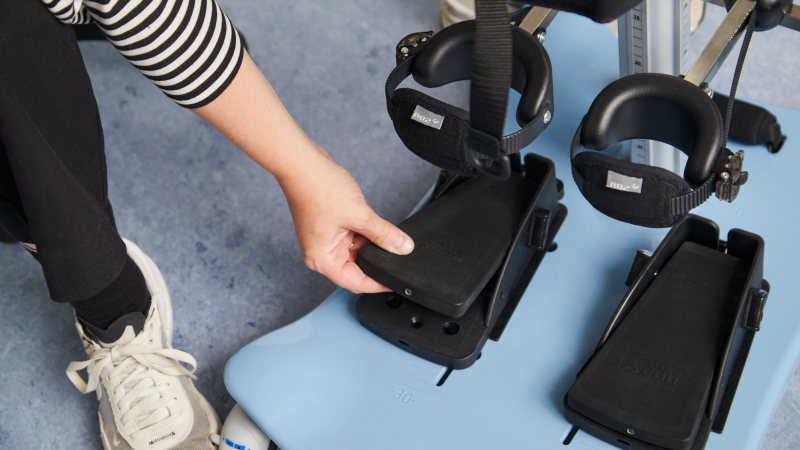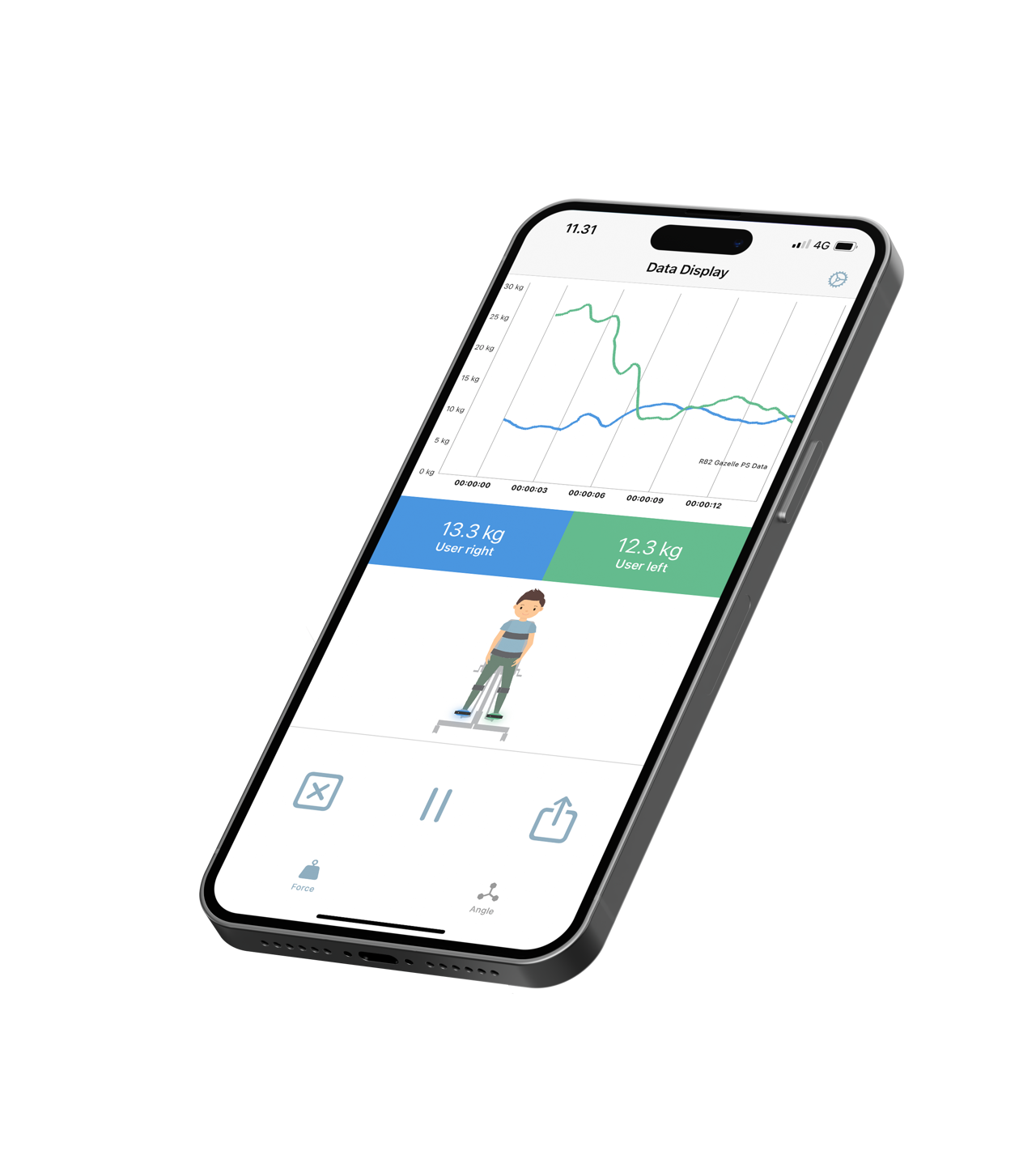
Why use a standing frame?
The use of a standing device can help to support the child’s development of independent standing, or to compensate for a lack of development.
Enabling the child to maintain a standing position will let the child apply different loads on their bones, joints and muscles. This will make it possible to develop new skills and prevent secondary consequences of the health condition from affecting the child.
Standing frames are widely used as part of postural management for children with disabilities (1-2). Therapists commonly prescribe the use of standing devices to children who are unable to stand or walk independently, often with the intent to gain weight-bearing on the lower-extremities.
Yet only little is known about the degree of weight bearing while in a standing frame.

What affects weight bearing?
Documenting the effectiveness of interventions using standing frames is complex. But there are indications that the use of standing frames leads to positive benefits for the user. Some associated with the muscular skeletal system such as improved bone density and joint development, others associated with the cardiovascular-, respiratory and digestive systems and even benefits such as improved mental functions and interactions with peers (2, 3-7, 8-9).
However, studies investigating what weight-bearing occurs during a standing session and what affects the degree of weight-bearing is very limited.
An exploratory study suggests that weight-bearing can be affected by many varying parameters and changes. This includes parameters and changes such as, type of frame, use of supports, inclination, activities performed while standing, use and degree of abduction and the orientation of the child, in either a prone or supine position (9).
The lack of information about weight-bearing in clinical settings makes it impossible to document the potential setup for optimal support and make recommendations for weight-bearing and alignment in a standing frame. Accordingly, there is a need for technologies for use in clinical practice, which can document the intensity of weight-bearing while in a standing frame.

How does Pondus support the standing position?
Pondus gives you guidance on the current weight alignment when the user is placed in a standing device. It enables you to make objective assessments based on the real time feedback of the force applied to the Pondus plates during a standing session. The assessments can then be used to guide the positioning of the user during both the current and future standing sessions.
Through real time readings you will be able to track and understand the effects of your actions and changes to the standing device as you try to tailor it to the individual child. You can now monitor how changes to the standing position influence the force applied to the plates. This allows for objective assessment of the intensity in terms of weight-bearing.

Analysing Pondus data on standing
In the R82 Pondus App you will be able to read the force applied over time based on individual readings from the right and the left Pondus plates, giving you guidance on the current weight alignment. Through the App you will get data from both plates. The data can be analyzed and used as guidance while setting up the standing frame or as the standing session is about to begin. It can also be used during the session to monitor if activities impact the force alignment and even after the session as the data report can be exported as both PDF and .csv file.
The 10 last sessions will be stored locally on the mobile device and can be retrieved and exported.
The PDF enables you to read the optional input ahead of the standing session as well as a graphic display of the exported standing session. The .csv file will give you access to all the raw data input, with 10 samples per second allowing in-depth analysis and interpretation of the data possible to use in external statistic software.

Future studies on Pondus and the use of standing frames
It is important for R82 to promote evidence based clinical practice and promote knowledge that can benefit the children using our devices. Therefor an industrial Ph.D. project has been initiated, in cooperation with the University of Southern Denmark, to gain more knowledge of this area of clinical practice and to do research on R82 Pondus.
The Ph.D. project aims to explore the importance of and the attitudes towards weight-bearing during the use of standing frames by enhancing the clinical evidence about Pondus and how Pondus affects potential short-term benefits and changes in prescription of the use of standing frames.
The Ph.D. project consists of three different studies. The first study will explore experiences and perspectives on the current use of standing frames. The second study will document the consistency of force and positioning in a standing frame using Pondus. And a last study will document potential short-term benefits and changes in prescription from the prescribing therapist when Pondus is applied opposed to current practice.
Literature
1) Goodwin J, Lecouturier J, Smith J, Crombie S, Basu A, Parr JR, Howel D, McColl E, Roberts A, Miller K, Cadwgan J. Understanding frames: A qualitative exploration of standing frame use for young people with cerebral palsy in educational settings. Child Care Health Dev. 2019 May;45(3):433-439. doi: 10.1111/cch.12659.
2) Paleg GS, Smith BA, Glickman LB. Systematic review and evidence-based clinical recommendations for dosing of pediatric supported standing programs. Pediatr Phys Ther. 2013 Fall;25(3):232-47. doi: 10.1097/PEP.0b013e318299d5e7.
3) Capati V, Covert SY, Paleg G. Stander use for an adolescent with cerebral palsy at GMFCS level V with hip and knee contractures. Assist Technol. 2019 Apr 4:1-7. doi: 10.1080/10400435.2019.1579268.
4) Han EY, Choi JH, Kim SH, Im SH. The effect of weight bearing on bone mineral density and bone growth in children with cerebral palsy: A randomized controlled preliminary trial. Medicine (Baltimore). 2017 Mar;96(10):e5896. doi: 10.1097/MD.0000000000005896.
5) Macias-Merlo L, Bagur-Calafat C, Girabent-Farrés M, A Stuberg W. Effects of the standing program with hip abduction on hip acetabular development in children with spastic diplegia cerebral palsy. Disabil Rehabil. 2016;38(11):1075-81. doi: 0.3109/09638288.2015.1100221.
6) Macias-Merlo L, Bagur-Calafat C, Girabent-Farrés M, Stuberg WA. Standing Programs to Promote Hip Flexibility in Children With Spastic Diplegic Cerebral Palsy. Pediatr Phys Ther. 2015 Fall;27(3):243-9. doi: 10.1097/PEP.0000000000000150.
7) Hough JP, Boyd RN, Keating JL. Systematic review of interventions for low bone mineral density in children with cerebral palsy. Pediatrics. 2010;125(3):e670-e678. Doi:10.1542/peds.2009-0292
8) Pedlow_K, McDonough_S, Lennon_S, Kerr_C, Bradbury_I. Assisted standing for Duchenne muscular dystrophy. Cochrane Database of Systematic Reviews 2019, Issue 10. Art. No.: CD011550. DOI: 10.1002/14651858.CD011550.pub2.
9) Paleg G, Altizer W, Malone R, Ballard K, Kreger A. Inclination, hip abduction, orientation, and tone affect weight-bearing in standing devices. J Pediatr Rehabil Med. 2021 May 28. doi: 10.3233/PRM-190660. Epub ahead of print. PMID: 34057103.
